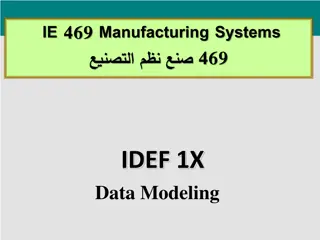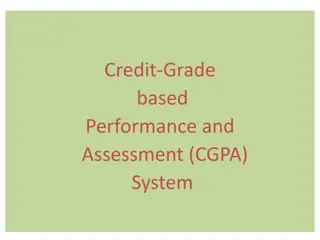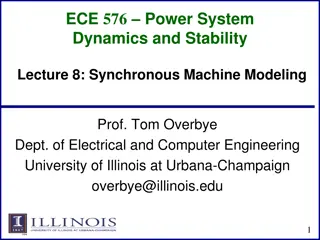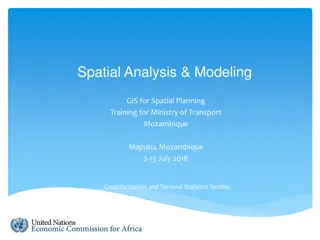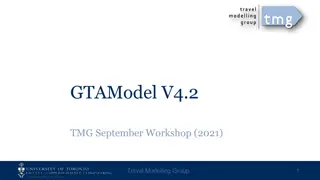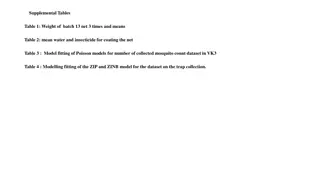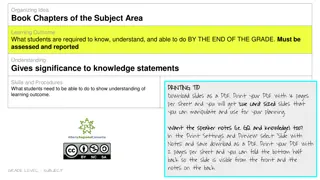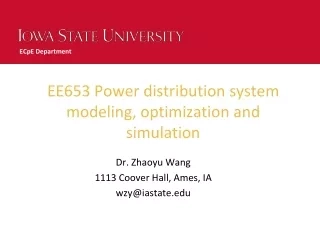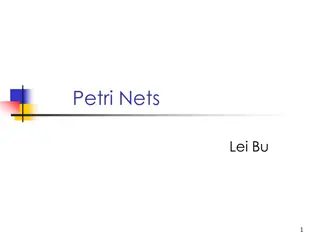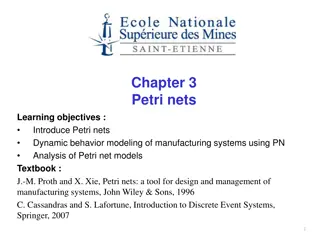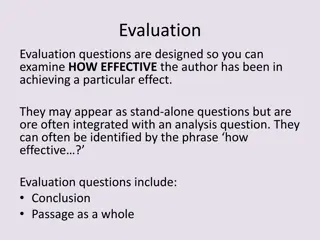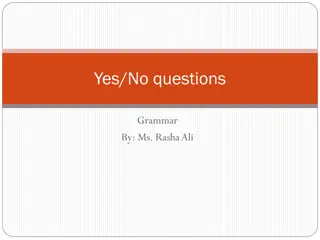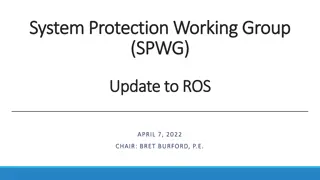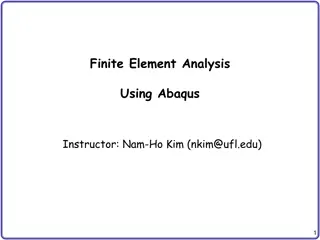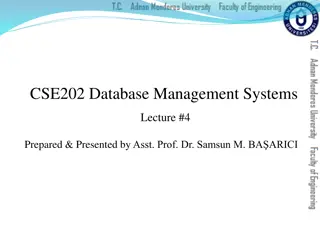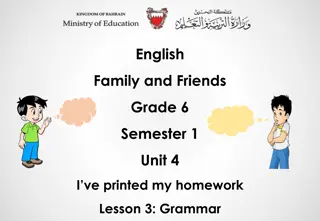Grade 8 Modeling and Data Analysis Questions
Explore sample modeling and data analysis questions for 8th grade including determining the percentage of a corn silo filled, analyzing a scatter plot, and interpreting a graph on child language development.
Download Presentation

Please find below an Image/Link to download the presentation.
The content on the website is provided AS IS for your information and personal use only. It may not be sold, licensed, or shared on other websites without obtaining consent from the author. Download presentation by click this link. If you encounter any issues during the download, it is possible that the publisher has removed the file from their server.
E N D
Presentation Transcript
Claim 4 Smarter Balanced Sample Items Grade 8 Modeling and Data Analysis Questions courtesy of the Smarter Balanced Assessment Consortium Item Specifications Version 3.0 Slideshow organized by SMc Curriculum www.ccssmathactivities.com
#1 An empty corn silo in the shape of a cylinder is being filled with corn. The silo is filled at a constant rate for a total of 10 hours. The table shows the amount of corn, in cubic feet, in the silo at the given number of hours after filling started. Number of Amount of Corn (cu ft) Hours 0 0 3 2475 5 4125 8 6600 Enter the percent of the silo that is filled with corn at 10 hours.
#1 Answer Rubric: (2 points) The student enters the correct numerical value for the percent of volume that is filled at the end of 10 hours (accept the range 90.9 - 91). (1 point) The student gives the amount filled after 10 hours (8250) but forgets to find the percentage of the filled amount to the volume OR the student finds the volume of the silo only (9072.9 9073).
#2 This scatter plot shows the lengths and the widths (in millimeters) of the eggs of some American birds. Use the information in the scatter plot to support each answer. Part A The scatter plot shows an association between the length of a bird egg and its width. Describe that association. Part B Fossils show that dinosaur eggs closely resemble the shape of bird eggs. One such dinosaur (sauropods) grew from eggs that were 180 millimeters in length. Assume that sauropod eggs were the same shape as bird eggs. What is the approximate width, in millimeters, of sauropod eggs? Explain how you determined your answer.
#2 Answer Rubric: (2 points) The student is able to answer both parts correctly and provide sufficient explanation/support for the answer to Part B. (1 point) The student only answers one part correctly.
#3 This graph shows the average number of words a child can say from birth to 36 months. Which statement is the most accurate description of the growth in the number of words a child speaks based on the graph shown? A. Children learn to say new words at a steady rate starting about 12 months of age. Children are constantly learning to say new words from the moment they are born. Children learn to say new words more slowly during their second year than during their third year. Children begin learning to say words around 24 months and stop learning to say new words at 36 months. B. C. D.
#3 Answer Rubric: (1 point) The student chooses the best interpretation of the graph. Answer: C
#4 Cory is buying copper for a construction project. He pays $1.85 per pound of copper for the first 100 pounds. He pays $1.75 per pound of copper for every pound over 100 pounds. Cory calculated that it would cost $228.75 to purchase 125 pounds of copper. He writes an algebraic equation that will allow him to determine the cost of copper for any number of pounds of copper over 100 pounds. Let y be the amount of money, in dollars, Cory pays for x total pounds of copper when x is greater than 100. y = a(x 100) + b Determine the values of a and b that Cory used to calculate the total cost for any purchase over 100 pounds of copper. Enter the value of a in the first response box. Enter the value of b in the second response box.
#4 Answer Rubric: (1 point) The student enters the correct values for a and b. Answer: a = 1.75 and b = 185
#5 This table represents the cost of renting a truck from Moving Company X and Moving Company Y. Each company charges a one-time rental fee plus a charge for each mile driven. Part A Use the Add Arrow tool to graph two linear equations that represent the cost of using each moving company given a number of miles driven. Part B Select the moving company that will be the least expensive to move between the given cities. Refer to the map shown to determine the distances.
#5 Answer Rubric: Each part of this item is scored independently for a total of 2 points. Part A (1 point) The student correctly graphs both functions. Part B (1 point) The student selects the correct cells in the table. Answer: Examples
#6 The relationship between Jack s distance from home and time since he left home is linear, as shown in the table. Time (hrs) Distance (mi) 0 7.5 2 17.5 4 27.5 Based on the table, determine whether each statement is true. Select True or False for each statement. Statement True False Jack s initial distance from home is 7.5 miles. Jack s distance increases by 5 miles every 1 hour. Jack s distance from home at 3 hours is 23.5 miles
#6 Answer Rubric: (1 point) Student determines each statement as being either true or false. Answer: T, T, F
#7 An empty tank in the shape of a cylinder is being filled with water. The tank is filled at a constant rate for a total of 10 hours. The figure shows the height of water in the tank at the given number of hours after filling started. Enter the percent of the tank that is filled with water at 10 hours.
#7 Answer Rubric: (2 points) The student enters the correct numerical value for the percent. (1 point) The student gives the height of the water in the tank after 10 hours (30 30.1) OR the volume of water in the tank after 10 hours (8500 8532) but forgets to find the percentage. Answer: any answer between 93.75 - 94
#8 Select all situations that can be modeled by the linear equation y = 2x+5. A. There are initially 5 rabbits on the farm. Each month thereafter the number of rabbits is 2 times the number in the month before. How many rabbits are there after x months? B. Joe earns $2 for each magazine sale. He also earns $5 for each hour he spends trying to sell magazines. How much money will he earn after selling magazines for x hours? C. Sandy charges $2 an hour for babysitting. Parents are charged $5 if they arrive home later than scheduled. Assuming the parents arrived late, how much money does she earn for x hours? D. Sneak Preview is a members-only video rental store. There is a $2 initiation fee and a $5 per video rental fee. How much would Laney owe on her first visit if she becomes a member and rents x videos? E. Andre is saving money for a new CD player. He began saving with a $5 gift and will continue to save $2 each week. How much money will he have saved at the end of x weeks?
#8 Answer Rubric: (1 point) The student identifies all situations modeled by the equation. Answer: C and E
#9 This scatter plot and line of best fit show the relationship between the height and mass of 15 different dog breeds. The mass of the Afghan Hound is less than would be predicted by the line of best fit, and the difference between the predicted mass and the actual mass is greater than for any other breed. Click on the point in the scatter plot that corresponds to the Afghan Hound.
#9 Answer Rubric: (1 point) The student clicks the point that is below and farthest away from the graph. Answer:
#10 The table shows the relationship between the average number of hours students studied for a mathematics test and their average grade. Which type of function is most likely to model these data? A. Linear function with positive rate of change. B. Linear function with negative rate of change. C. Non-linear function that decreases then increases. D. Non-linear function that increases then decreases.
#10 Answer Rubric: (1 point) The student recognized the function most likely to model the data. Answer: D

















